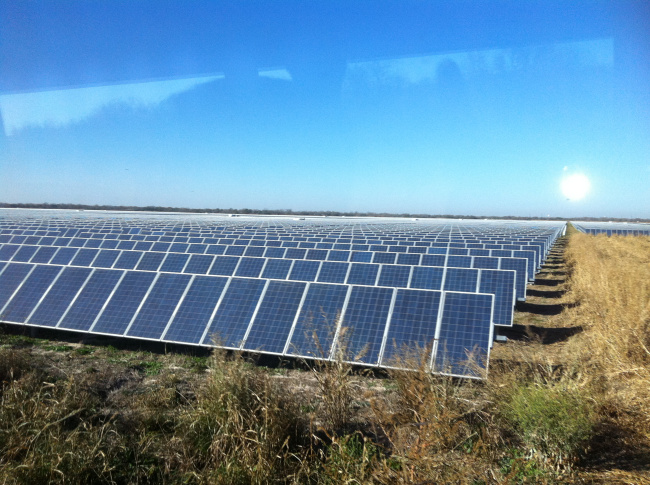By Cyrus Reed, Conservation Director

If you’ve heard about the rise of solar power in Texas, chances are you’ve heard about it in the context of big cities like Austin and San Antonio announcing big projects. These two cities have gotten a lot of accolades in the past ten years for their forward-thinking clean energy initiatives, and deservedly so. Hundreds of megawatts of solar power have come online from contracts signed by the two publicly-owned utilities - Austin Energy and CPS Energy.
However, other “less obvious” utilities have begun to invest in solar power. Georgetown (north of Austin) and Denton (north of Dallas) are two examples. These two cities have also committed to going 100% renewable energy.
But recently a new group of publicly-owned utilities put out a “request for proposals” (RFP for short) asking solar developers to submit their best plan to build up to 500 MW of solar power. Led by New Braunfels Utilities, a relatively conservative city north of San Antonio, the RFP specifies 120-150 MW of solar power would be for New Braunfels and up to 350 MW of solar for five other public utilities: Denton Municipal Electric, Garland Power & Light, Bryan Texas Utilities, Greenville Electric Utility System, and Kerrville Public Utility Board.
Solar continues to spread across Texas. Utility-scale solar competes and even beats “traditional” energy resources on cost alone. Some of the earlier large-scale solar contracts (early, like 2012) cost somewhere in the neighborhood of $150 per Megawatt-hour (MWh).That was a hefty (but necessary) price to pay to pave the way for more widespread investment. In contrast, a recent solar contract in Texas reportedly was somewhere around $30/MWh. More utilities are beginning to view solar (and wind) resources as good for both their pocketbook and the planet, as more and more citizens demand a local response to climate change.
Could This Solar Project Disrupt Dirty Coal Power In Texas?
Yes, in two ways. First, every megawatt of solar (or wind production) that comes on our electric grid is a megawatt of power that is not met by coal or natural gas plants. The more that happens, the more pressure is put on those polluting plants to retire. Second, in this particular case, four of the utilities in this recent solar RFP are the owners of a particular coal plant - Gibbons Creek.
Garland, Denton, Bryan, and Greenville together form the Texas Municipal Power Agency (TMPA). TMPA is the owner of the 470 MW coal-fired Gibbons Creek Steam Electric Station, which started operating in 1984 and which, when fully operating, burns some 6,000 tons of coal a day from Wyoming. While the plant is currently mothballed due to power prices being too low, TMPA is planning to run it this summer as demand is expected to be high and power prices will go up. Still, Greenville has already announced it plans to stop using power from the coal plant on September 1, 2018, while the three remaining utilities are discussing a short-term fix of continuing to rely on the coal plant until the summer high electric demand season ends on September 30, then mothballing the plant and looking at options to sell or retire the plant.
As previously mentioned, the Denton City Council adopted a new renewable resource plan that commits them to covering 100% of their electric demand with renewable resources by the end of 2020. Part of that plan involves getting out of the Gibbons Creek coal plant either by selling or retiring it before that date.
Thus, while the plant may be used in the short-term, in the long term, the combination of bad economics for imported coal, plus a desire to move toward newer, cleaner energy sources like solar, should help transition these utilities off coal. Sierra Club will be urging those cities to opt for retirement, not sell it off to someone else for a short-term gain.
What About Energy Storage?
While the RFP is focused on utility-scale solar, the RFP states that developers may present solar plus storage scenarios. Adding energy storage to solar development - depending on costs - could make these resources even more valuable, since solar plants can not produce electricity in the dark.
Developers have until April 10 (5pm to be exact) to get their bids in for this mega-solar RFP, which you can download here. As the largest investor, New Braunfels expects to pick the winning bid by May 11 for their portion of the RFP.